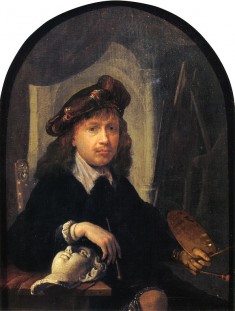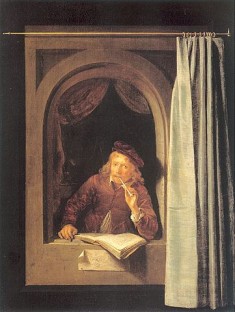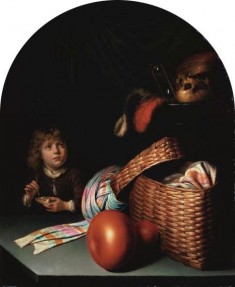| Gerrit Dou | |
|---|---|
 |
|
| Born | Apr. 7, 1613 Leiden, Netherlands |
| Died | Feb. 9, 1675 (at age 61) Leiden, Netherlands |
| Nationality | Dutch |
| Movement | Baroque |
| Field | Painting |
| Works | |
He was considered among the greatest painters of his day, but the works of Dutch artist Gerrit Dou eventually receded into obscurity.
Early Life
Dou, also known as Gerard Douw in England, was born in 1613 in Leiden, a town in southern Holland. During his early years, he studied drawing under Bartholomew Dolendo, an engraver in his area. He also learned about painting on glass by Peter Kouwhoorn.
At 15 years of age, DouHe studied under one of the renowned Dutch artists – Rembrandt. His master’s style and theory of art would be a significant influence on Dou for the remainder of his career.
Even though Rembrandt was a heavy influence on him, Dou developed a highly distinct style and he sometimes produced works that were in opposition to the essential elements of Rembrandt. At the same time, Dou’s work shows many of the characteristics that make it recognizable as work in the style of the Dutch Golden Age of painting, generally considered to be from 1568 to 1648.
Four Elements of Dou’s Art
There are basically four elements of a Dou painting. For one, Dou enjoyed producing genre art, which are scenes of everyday life and the ordinary events of life in mid-17th century Holland. This included streets scenes, kitchen scenes, people gathered around tables for meals, children playing, and so forth.
 Another popular element in Dou’s art is chiaroscuro. This is the presence of strong contrasts between light and dark, which influences the entire theme of the painting. Chiaroscuro also used to create a certain three-dimensional effect of objects and human figures.
Another popular element in Dou’s art is chiaroscuro. This is the presence of strong contrasts between light and dark, which influences the entire theme of the painting. Chiaroscuro also used to create a certain three-dimensional effect of objects and human figures.
Thirdly, Dou used a technique called “trompe l’oeil,” which was used by Dutch artists to give specific objects (but mostly people) a certain three-dimensional characteristic. For example, a self-portrait of Dou has him leaning out a balcony window and his figure appears to emerge from or against the frame of the structure.
Finally, Dou was experienced at creating extremely fine imagery that shows objects with tremendous clarity down to very fine detail. His paintings are incredibly precise in the rendering of the minute. At times, Dou would take several days just to paint a hand.
Even though Dou achieved tremendous clarity of detail, there was also a softness and fluidity to his work. His use of color showed the command that he had of his own inner vision. Dou was able to look at ordinary scenes and objects and transform them into something special.
Works of Art
 Dou’s two greatest works are often considered to be The Dropsical Woman and The Dutch Housewife. The first depicts an ailing woman reclining in a chair as she is being ministered to by a physician and comforted by a little girl. The scene shows an upper-class individual in rich surroundings. The “dropsical” woman at the center of the image is adorned in flowing white and gray robes. This painting is dated 1663.
Dou’s two greatest works are often considered to be The Dropsical Woman and The Dutch Housewife. The first depicts an ailing woman reclining in a chair as she is being ministered to by a physician and comforted by a little girl. The scene shows an upper-class individual in rich surroundings. The “dropsical” woman at the center of the image is adorned in flowing white and gray robes. This painting is dated 1663.
The Dutch Housewife depicts a possibly working class woman holding a recently killed chicken upside down as she leans out of a stone-arched window. Her elbow rests on a basket that appears to be made of brightly polished bronze. It seems as though she might be a servant in a wealthy household. However, she is identified as a housewife. This painting was completed in 1650.
Both of the pieces mentioned are enshrined in the Louvre in Paris.
Appeal
During his lifetime, the works of Dou were highly sought after and received universal praise. Thus, his art commanded a high price, enabling Dou to live a prosperous lifestyle. He was known throughout Europe and he even received an invitation to receive a personal audience with King Charles II of England.
Rediscovering Dou
However, his art seemed to have been largely forgotten soon after his death in 1675. His contemporaries, such as Rembrandt and Johannes Vermeer, remained well-known and powerful forces in the art world throughout the centuries. Many consider Dou to be their equals, but he never achieved the popularity for his work that they obtained for theirs.
Gerrit Dou’s work is being rediscovered today. Starting in the 1970s, art historians began to actively resurrect, write about, and study his work, which has been bringing him back out of obscurity. About 60 of his paintings are believed to survive today, although several are attributed to him without 100% certainty.
